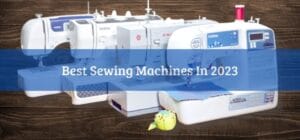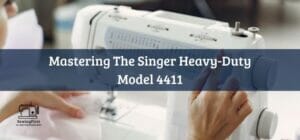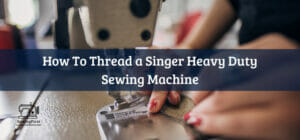When was the last time you bought a new sewing machine? Do you even remember where you put it?
If you’re tired of lugging around heavy boxes full of old sewing machines, then you should consider putting a new sewing machine on an old table. This will make your sewing experience much more enjoyable and convenient.
I’ll show you how to put a new sewing machine in an old table. You’ll learn how to choose the right size table, how to measure the space, and how to cut the wood. Then I’ll show you how easy it is to install the sewing machine. Finally, I’ll teach you how to set up the machine and get started sewing!
Related Topic: How to Make a Sewing Machine Extension Table: Be the Pro You Wanted To Be
Table of Contents
ToggleGetting Started: Things You’ll Need
If you’re looking to put a new sewing machine in an old table, there are some things you need before you begin. The most important item is a sturdy work surface.
Old wooden tables can be used for sewing machines. But you’ll need to sand down any rough edges and smooth out the top. Then paint the table white to give it a clean finish.
Next, find a place where you can store your sewing supplies. This may mean adding shelves to the wall above the table. Or maybe you can add storage drawers below the table. Whatever works for you.
Finally, you’ll need a few tools. A tape measure is essential because you’ll be measuring the space that you want to use for the sewing machine.
A pencil or marker is helpful when marking the measurements on the table. And a hammer is useful if you have to knock holes into the table.
Measurement Tips
When choosing a table for your sewing machine, keep these tips in mind.
The first thing to do is decide whether you want to buy a portable sewing machine or a stationary one. Portable sewing machines are great for traveling. They fold up easily and take up less room than stationary ones. However, they don’t usually come with all the attachments that you’d find on a stationary machine. So you might not be able to sew as many different types of projects.
If you plan to sew clothing, look for a sewing machine that has a built-in foot pedal. It’s easier to control the needle position while wearing shoes.
If you plan on sewing quilts, look for a sewing table that folds flat so you can pack it away easily.
Measurements: Step 1
The next step is to measure the area you want to use for your sewing machine. Measure from the front edge of the table to the back edge. Make sure to include the width of the table itself. Also, measure from the left side of the table to the right side. If you’re using a portable sewing machine, this measurement includes the length of the table.
Cutting Wood: Step 2
Once you know what size table you want, you’ll need to cut the wood to fit. Use a circular saw to cut the wood. Cut two pieces of wood equal to the length of the table plus half the height of the table. For example, if you want a 10″ wide table, cut two pieces of wood 12″.
Sanding & Painting: Step 3
Sand the table until it’s smooth. Then apply three coats of clear polyurethane varnish. Let each coat dry completely between applications.
Installing the Sewing Machine: Step 4
Now that you’ve got everything ready, it’s time to install the sewing machine! First, remove the bolts holding the table together. Then slide the table onto the floor. Next, lift the table off the ground and carefully lower it onto the base of the sewing machine.
Attach the feet to the bottom of the table. Then attach the table to the sewing machine by screwing the legs into the sides of the machine. Finally, tighten the screws that hold the table to the base.
Finishing Touches: Step 5
You should now be done installing your sewing machine. Now that you have a nice, sturdy table, you can start sewing!
Old Sewing Cabinet For a New Sewing Machine
If you’re looking to put a new sewing machine in an old table, there are several options available. The most common option is to buy a new sewing machine stand. However, if you already have an old sewing cabinet, you may be able to repurpose it instead.
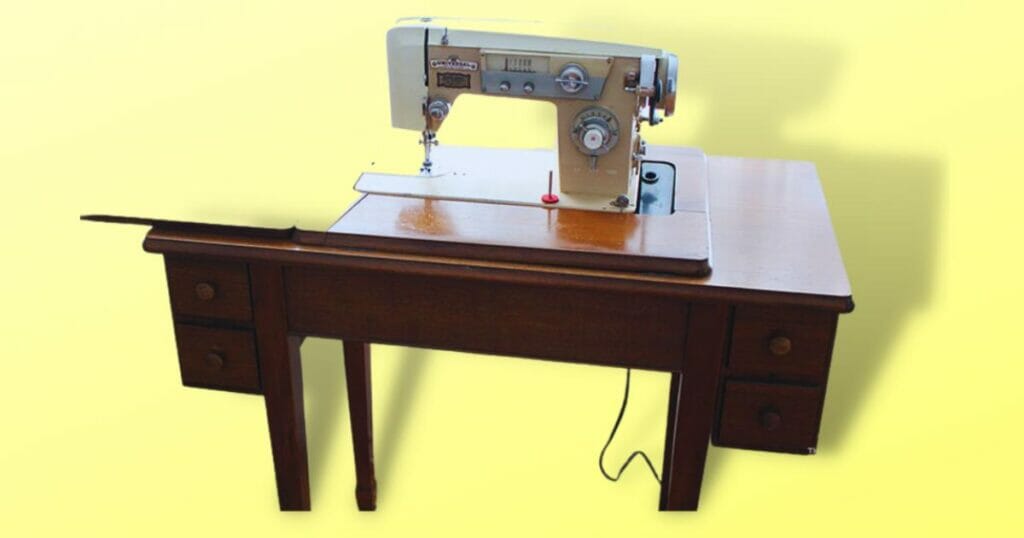
An old sewing cabinet has many uses besides just holding a sewing machine. For example, it can hold fabric rolls, patterns, scissors, and other supplies. Plus, it makes a great storage space for small items like buttons, thread spools, and safety pins.
To turn an old sewing cabinet into a sewing machine stand, simply remove the shelves and drawers. Then drill holes through the bottom of the cabinets and attach them to the base of the sewing machine.
Once you’ve finished drilling holes, add screws in screw holes to secure the cabinets to the base of the machine. Now you can store your sewing machine inside the cabinet and keep everything organized.
Repurposing an Old Sewing Machine Table For a New One
Sewing machines come in many different shapes and sizes. Some are small enough to fit on a desk, others are large enough to stand next to a bed. But no matter which one you choose, there’s only one place where you should put it – on top of an old sewing machine table!
A vintage sewing machine table is perfect for storing your sewing machine. Not only does it keep your sewing machine safe, but it also provides extra storage space for accessories, thread spools, and fabric rolls. Plus, it makes your sewing room look great!
If you’re looking for a new sewing machine, you may not realize that most sewing machines today are designed to work on a flat surface. So, before you buy a new sewing machine, consider buying an old sewing machine table instead.
There are two main types of sewing machine tables: wooden and metal. Wooden sewing machine tables are made out of wood, plywood, particle board, or some combination of these materials. Metal sewing machine tables are usually made out of steel, aluminum, or stainless steel.
Wooden sewing machine tables are typically cheaper than metal ones. However, they tend to warp over time, especially if they aren’t properly stored. They also require regular maintenance, including cleaning and oiling.
Metal sewing machine tables are sturdier than wooden ones. They won’t warp or crack, and they last longer. However, they cost more than wooden ones.
Regardless of whether you decide to go with a wooden or metal sewing machine table, you need to store them carefully. Make sure they’re well protected from dust, moisture, and heat. Also, clean them regularly to prevent rust.
When choosing between wooden and metal sewing machine tables, remember that metal ones are heavier. This means that they take longer to move around. On the other hand, wooden ones are lighter, so they’re easier to carry.
To find a used sewing machine table, visit local thrift stores, garage sales, estate sales, and flea markets. You can also search online for used sewing machine tables.
Once you’ve found a suitable sewing machine table, you’ll need to figure out where to put it. The ideal location depends on the size of your sewing room.
If you have a lot of free floor space, you can simply leave your sewing machine table right where it is. However, if you have limited space, you’ll need to think about where to put it.
Ideally, you’d like to position your sewing machine table near your sewing machine. But if you can’t, at least try to arrange things so that your sewing machine is within reach.
Sewing Machine Tables: For Different Types Of Sewing Machines
Sewing Machine Tables
Keywords: domestic sewing machine, industrial sewing machines
When putting a new sewing machine in an old table, there are two main considerations:
- The type of sewing machine
- Where to put the sewing machine.
There are three different types of sewing machines: Domestic, Industrial, and Home Use. Each has its advantages and disadvantages.
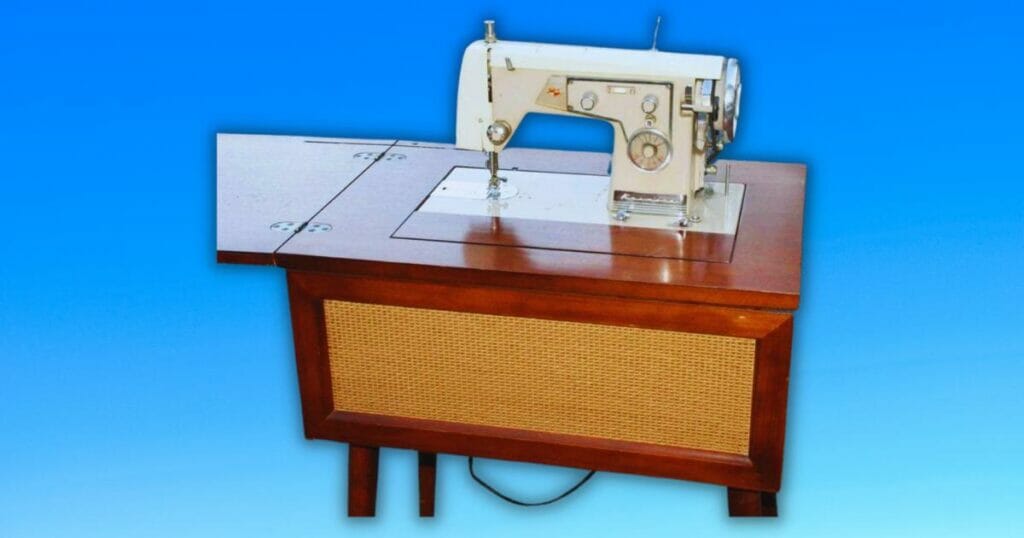
Domestic sewing machines are great for beginners who just need to sew simple items. They’re inexpensive and easy to operate. However, they lack power and speed.
Industrial sewing machines are powerful and fast, but expensive and hard to maintain. They’re ideal for professionals who need to produce quality work quickly.
Home-use sewing machines are affordable and versatile. They’re perfect for intermediate users who need to sew many things at once. But they lack power and speed compared to industrial sewing machines.
To decide which type of sewing machine to buy, consider these factors:
- Your budget
- What kind of projects do you plan to sew
- Whether you prefer manual or automatic sewing
- How often do you intend to sew
- How much space do you have available
- How much experience do you have with sewing
Sewing Machine Table for Upcycling and DIY Projects
Upcycling is the process of turning something old into something new. This includes repurposing items that would otherwise end up in landfills.
DIY projects are fun and creative ways to improve your home. They’re also great for saving money and creating unique gifts.
If you’ve got a sewing machine table that’s collecting dust, now’s the perfect time to turn it into a useful tool for upcycling and DIY projects.
First, remove any hardware from the table legs. Then sand down the wood until smooth. Next, apply stain or paint to match your existing furniture. Finally, add some finishing touches, such as drawer pulls, knobs, hinges, etc.
Now you’ve got a beautiful sewing machine table that doubles as a handy work surface for upcycling and crafting.
Sewing Machine Craft Table
A sewing machine craft table is a small table designed specifically for sewing machines. They usually come with a built-in light source, which makes them perfect for working at night.
They’re also great for storing sewing supplies, including thread spools, needles, scissors, etc. Some models include storage drawers underneath the work surface.
There are two main types of sewing machine craft tables: stationary and portable. Stationary ones are permanently fixed to a wall or desk. Portable ones fold up and store easily.
Both types of sewing machine craft tables are available online and in stores. However, some people prefer stationary sewing machine craft tables over portable ones. This is because stationary ones are typically cheaper than portable ones.
Portable sewing machine craft tables are often better suited for beginners who just want to learn how to sew. On the other hand, stationary sewing machine craft tables are ideal for experienced seamstresses who already know how to sew.
Regardless of type, sewing machine craft tables are a smart investment. They help keep your sewing machine clean and organized, and they protect your sewing machine from damage.
When choosing a sewing machine craft table, consider the materials used to build your sewing machine craft table. Wood is a popular material, but it tends to warp over time. Acrylic is another option. It’s lightweight, durable, and stain-resistant.
Finally, consider the price. Most sewing machine craft tables cost between $50-$100. But prices vary depending on the model and features.
How to Make Your Own Sewing Table
A sewing machine table is essential for keeping your sewing machine safe and secure while you use it.
You can make one yourself using scrap wood and metal. Or you can purchase readymade stands.
Here’s how to build your own sewing machine stand:
- Cut four pieces of 2×4 lumber to length. These will be the base of your stand.
- Drill holes through each piece of wood. The hole size should be about half the diameter of the shaft of your sewing machine spindle.
- Attach the pieces together by driving screws through the holes.
- Sand the edges of the stand to smooth them out.
- Paint the stand black.
- Screw on a pair of casters so that you can move the stand around easily.
- If you want to protect your sewing machine from scratches, attach a protective cover.
- Now you’ve got a sturdy sewing machine stand that looks good too!
How to Renovate a Sewing Machine Cabinet by Yourself
Renovating a vintage sewing machine cabinet is a great option because it saves space and makes room for a new sewing machine. Plus, it gives you a unique piece of furniture that you can pass down through generations.
This project requires basic carpentry skills and tools like a drill, saw, hammer, screwdriver, tape measure, pencil, ruler, level, and glue gun.
Start by removing all of the hardware from the old sewing machine cabinet. You’ll need to remove the hinges, latches, drawer slides, handles, knobs, and pulls.
Next, cut the plywood into three equal sections. Each section should be at least 3 inches thick.
Cut the plywood into the shape of the old sewing machine cabinet, making sure to leave enough room for the door.
Sand the plywood with 120-grit sandpaper. Then apply several coats of clear polyurethane sealer. Let dry completely before moving on to the next step.
Attach the plywood panels to the sides of the sewing machine cabinet frame. Use wood glue or construction adhesive to hold the panels in place.
Use a router to create decorative moldings along the top edge of the plywood panels. Cut the molding strips to fit the width of the panel.
Apply two coats of exterior paint to the entire cabinet. Allow the paint to dry thoroughly before applying additional coats.
Once the paint has dried, install the new hardware. Attach the hinges, latches, and drawer slides.
Install the handle and knob. Add a pull handle if desired. To finish off the project, add some finishing touches such as a doorknob.
Conclusion
When putting a sewing machine on an old table, you need to consider several factors. First, you need to ensure that the table has enough space for the machine.
Second, you need to make sure that the table is sturdy enough to support the weight of the machine. Third, you need to make certain that the table is strong enough to hold the weight of the machine without breaking.
Finally, you need to make absolutely certain that the table is safe for the machine. In short, when putting a sewing machine on a table, you need to think carefully about every aspect of the project.


